World Dream Bank
home -
add a dream -
newest -
art gallery -
sampler -
dreams by
title,
subject,
author,
date,
places,
names
Capsica map, giant ref map, geography,
gazetteer
. More worlds? Planetocopia!

 Capsica
Capsica
UNDER CONSTRUCTION
by Chris Wayan, 2010-2024
This one's for you readers, who pestered me until I had to build it
INTRODUCTION
Capsica's an experimental model of a hot but living world. Most exobiology focuses on the chilly end of the the Goldilocks Zone, between freezing and 25° C (273-298° K or 32-77° F). Understandable, since Earth's around 15°C (60°F). But what about the rest of the liquid-water range? Capsica is neatly midway between freezing and boiling--50° C (122° F). Call that hot? Just shows you're the survivor of an Ice Age. Capsica, not Earth, is the real Goldilocks story: juuuuust right!
I did say average. But averaging hides a lot. Capsica turned out to be two worlds in one:
- LOWLANDS equivalent to our sea floors: very hot (40-70° C), with dense air (2.4 atmospheres). Violent weather but quick evaporation. From stormforest to desert. Plants are red to purplish. (Arbitrary choice: I want a clear marker for the hotlands, and the artist in me likes the color contrast.) These lowlands dominate Capsica: over 90% of the planetary surface, 80% of the land. Fliers predominate, including sapient ones. Examples: lowland Eel (wet), or Yaku and Az (dry).
- HIGHLANDS analogous to our continents: more Earthlike air pressure (1.2-1.8 atm) and temperatures. Abundant greenery (and green greenery; a different photosynthetic pigment isn't a scientific necessity but it marks uplands nicely). Upland animal life is less diverse, though, with no sapient fliers: Capsican body temperatures are high, so even a mild chill really burns calories. Or is this naïve? Maybe species will evolve with lower core temperatures, just as crabs have adapted to hot water near Earth's abyssal vents. This Terran terrain is limited: just 10% of the surface, 20% of the land. Examples: Hithluma, the Aksora Plateau.
- POLAR SHORES are borderzones--Terran temperatures, so green plants, but dense lowland air, so winged natives can fly. Well-insulated, of course, against the relentless Miami-like chill. Examples: the Antarctic and the Nohaa Flyway.
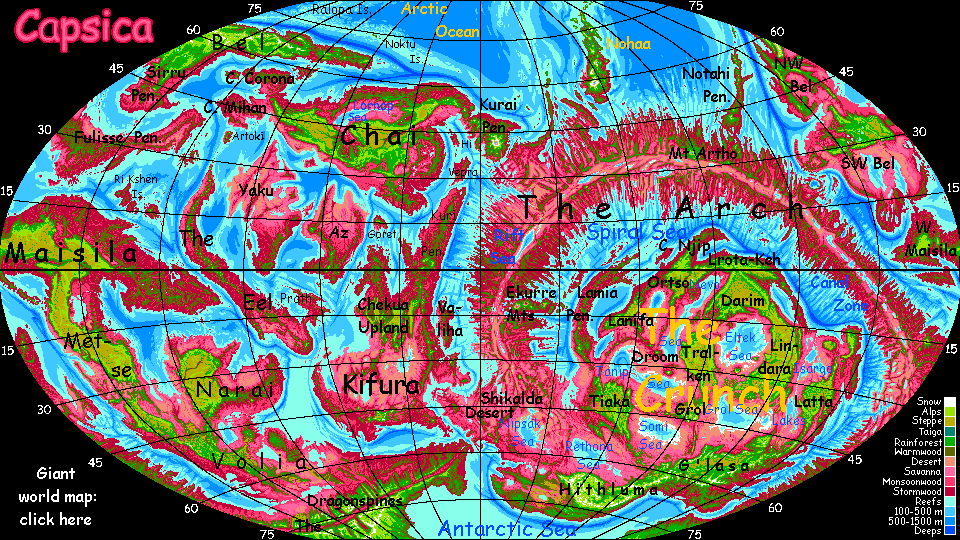 CAPSICA: BASICS
CAPSICA: BASICS
- Sun:
A yellowish star with 7% less mass than our sun, radiating about 30% less energy.
- Orbit = 0.7 to 0.9 AU (on average, 0.8; closer than Earth, further than Venus).
Orbital eccentricity heightens seasonal temperature swings in the north and the tropics. It also means Capsica has a short hot worldwide hurricane season, then a longer worldwide winter lull (still scorching and typhoon-happy by Terran standards).
- Insolation = 5-10% more than Earth's.
But that glosses over a big annual swing--from 81 to 133%! Still, compare this to Mars, with less than half Earth's light, or Venus, with nearly double--Capsica really is in the Goldilocks zone! It's hotter than Earth mostly because its dense air traps more heat, not because it gets that much more sunlight.
- Axial tilt = 20°.
A bit less than Earth, and probably more variable over deep time, since Capsica lacks a big moon to shepherd it. But this may not matter much, as we'll see. The current tilt has two effects:
- Temperature swings in the north where orbital and axial seasons coincide; the south generally has milder seasons.
- Monsoon belts flanking the equator--rainy summers,
drier winters. Essentially, the equatorial rains swing 20° north then south
during the year. Without this tilt, the dry zones around latitude 20-35°
might be still wider.
- Ultraviolet levels = low. Capsica's dense air blocks UV well, and its cooler sun produces less.
- Radiation levels = very low.
Capsica has a strong magnetic field, dense air, and its cooler sun produces less radiation. Is it too low? When I was a kid, it was feared you needed a sort of Goldilocks Zone for mutation-inducing radiation as well as for temperature--too much, and life sickened; too little, and evolution grinds to a halt. But we now know environmental change can kickstart adaptive changes up to one million times faster than Darwin postulated. Genes are adaptable little critters. Over a wide range of radiation levels, life will evolve just fine!
- Solar year = about 9 Terran months
- Seasons = strong and worldwide.
Capsica's eccentric orbit creates global warm and cool seasons. This means the equatorial belt is more seasonal than Terra's. During global winter, the tropics are merely hot and rainy; summer sees near-scalding hurricanes that'd kill a human in hours (what a way to go--wrinkled to death!) The high latitudes, too, have stronger seasons than Earth, particularly the northern hemisphere, whose axial and orbital summers roughly coincide. Neither polar basin ever freezes, but the growth-spurt during Arctic summer (Saharan heat) and the harsh winter (down to room temperature or less!) create a very different ecology than the steadier chill in the Antarctic (summers rarely above 40 C/104 F, and Hawaiian winters).
(Confession time! Plenty of real-life Capsicas are no doubt fatal to Terrans world-wide and year-round. I set my Capsica's orbital eccentricity high for artistic reasons: I wanted a global winter so my human readers would have at least a faint chance of surviving the regional tours. If I survive writing them... how many million square miles? How many words, maps, lines of code?)
- Mass = 0.45 Earths.
Why's Capsica so small?
- Smaller stars form from smaller nebulae; they're likelier to have stunted planets.
- The average star (and solar system) is also 25% poorer in heavy elements than Sol. So even good-sized stars may have rocky planets on the small side.
- Chance, that factor everyone downplays!
- A lot of stars have hot Jupiters in tight orbits. It's thought these giants spiral in, swallowing smaller planets in their way, or flinging them out of the solar system. But the most recent simulations suggest quite a lot of that flung material ends up in the habitable zone, though often in more eccentric orbits than before. The demolition derby does slow planet-formation; but in the end rocky planets often do form, if smaller, drier and more eccentric than Earth. Capsica's system lacks a hot Jupiter, but Capsicas are a plausible planet-type in hot-Jovian systems.
- I'm out to show "small is beautiful"--show how little rock and water it takes to make a healthy biosphere. If Capsica sounds too small, consider: carve it up, and you could build four Marses--with a Luna left over. (Yeah, Mars really is just 11% of Earth's mass! Just a pebble with good press.)
- Density = around 5 gm/ml,
more like Earth than Mars. A large iron core, then.
- Diameter = about 9600 km (6000 mi), or 3/4 Earth's diameter.
Nearly 50% larger than Mars's! Circumference is nearly 19,000 mi / 30,000 km. The 15-degree span between meridians (on most of the maps) is about 775 mi or 1250 km.
- Surface area = just over half Earth's--about 110 million square miles / 265 million sq km.
- Land area = over 90% of Earth's! 55 million sq mi / 140 million sq km.
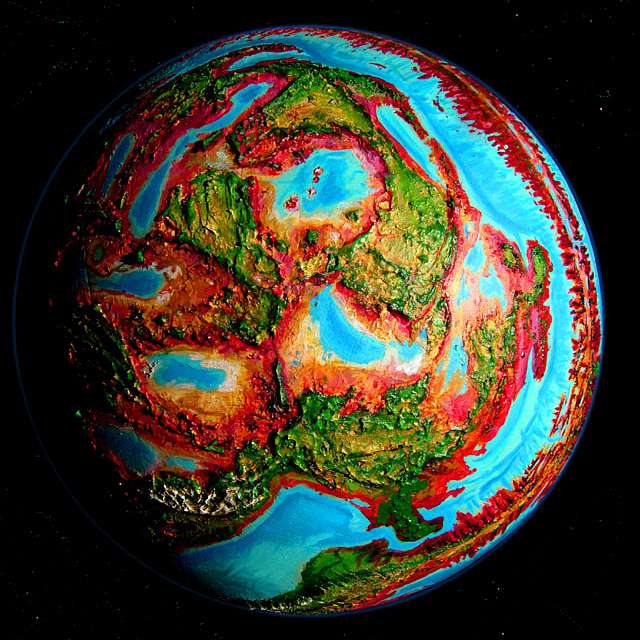
- Gravity = 0.67 G, midway between Earth's (1.00) and Mars's (0.38).
- Day = 30 hours.
The long day isn't due to tidal drag from the sun, mostly, but from Capsica's three small moons. None of them is anywhere near Luna's mass, but they're close enough to collectively exert more tidal drag on Capsica than Luna does on Earth. Capsica's tides rarely reveal this, since the moons pull at cross purposes most days. But when they line up every 9 days or so, watch out!
- Water = 20% of Earth's measured per square kilometer. In absolute terms it's only 10%! Why's Capsica so dry? I could argue:
- Fewer icy comets struck Capsica. Its solar system lacks a Jupiter; starting out dry as Earth, Capsica just got less of a cometary rain... I think! Jupiter's simultaneously cited as a comet-shield for Earth, AND seen as a comet-disturber--its perturbations helped shower our hot young world with outer-system ice, but overall, did Jupiter decrease or increase total comet-strikes on Earth? It's not as clear as some authors would have you believe. We need to see cratering rates in a bunch of solar systems lacking Jupiters--and THAT'll be a while yet!
- Capsica's dense, so its surface gravity is respectable; but still, it's small and its escape velocity is rather low. It's lost far more water than Earth, ever since it formed...
- ...and that's been a while! Capsica is old. It's been slowly bleeding air and water for six billion years! Capsica's tectonic vigor is all that's kept it young--volcanic outgassing adds new air, new water! So did Capsica start out Earthlike? Hard to say. There's a long history here we don't know. (We forget how long-lived small suns are. Earth's doomed to a short merry dance around its spendthrift sun.)
(Confession time again. Those were all excuses! I rigged Capsica to be rather dry because a hot wet planet was too easy to predict--and monotonous. A hurricane-lashed global Amazon! Hot and utterly dry? Dead, or nearly. But hot and sort-of-dry isn't so obvious. Evaporation rates are high, quickly parching soils, but also generating hurricanes--if the seas are big enough. And how far inland do these storms reach?)
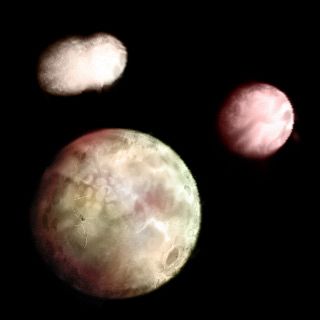
- Moons
= three. This suggests they are not the result of a Lunar-type catastrophic collision. Did they form in place, or were they captured? If so, not recently; orbital resonance suggests a long shared history. All are small and airless, but these aren't the tiny moons of Mars either:
- Peppercorn is a pitted, grooved potato shape, 180-240 km across. It's just 63,000 km out; from Capsica it looks about 3/8 as wide as Luna--variable of course. It orbits every 2.25 Capsican days. It's in orbital resonance with...
- Bell, the largest at 800 km diameter (500 mi), 100,000 km out. It orbits in 4.5 Capsican days--twice as long as Peppercorn. Bell's apparent width is 7/8 that of Luna; its light is actually brighter as its albedo is higher (Luna is quite dark as worlds go).
- Anaheim, 500 km in diameter, is 150,000 km out,
orbiting every 9 days, with an apparent diameter about 3/8 of Luna.
In short: Capsican nights are bright--not spectacularly, but there's nearly always one or more moons up. Assuming a cloudless sky. We have yet to learn about that...
- Tidal stress = high.
Capsica's three moons collectively exert over 50% more tidal drag than Luna; Capsica's smaller but closer sun also tugs the planet a bit harder. If Capsica had Terran oceans, tides would sometimes be high indeed. But Capsica's shallow little seas limit the "fetch" for tides to build up across; on most shores, they're a few meters or less. I did say most. Inlets focusing a sea's collective slosh can have tides higher than our Bay of Fundy.
- Internal heat and volcanic potential = Earthlike and then some!
Conflicting tidal stresses heat Capsica's core and mantle warmer than Earth's, stimulating vulcanism and plate tectonics. It's no Io, but it's hot. That's added to its climatic heat: the atmosphere is dense anyway, but volcanic gas, especially CO2, has helped to greenhouse Capsica.
- Seas = about 50% of surface area,
but averaging less than 1 km deep, compared with 3-4 km on Earth. Seas are of two types:
- The Ocean, a single spidery worldwide sea meandering between the uplands analogous to Terran continents and the snaky, mountainous fracture zones analogous to our mid-oceanic rifts.
- Dozens of small, shallow seas like our Caspian, of varying salinity, chemistry, temperature and altitude. Many are cut off from the world-sea by arcuate mountain ranges analogous to our island arcs.
- Land = 50% of Capsica's surface, or 140 million sq km (55 M sq mi)--almost comparable to Earth!
- 90% of the surface (80% of the land) is low, the geological equivalent of Earth's sea floor--basaltic basins with meandering rift zones. These (like the trenches fringing the uplands) often hold long lakes, as in East Africa. Nearly all Capsica's water pools here; a shallow ocean covers half this lowland.
- 10% of the surface (20% of the land) is high--uplands of lighter "continental" rock (Earth has 30%; Venus, 8%; Mars, 50%). Capsica, Venus and Mars have confused uplands, not neat platforms with clear, sharp continental drop-offs--our deep seas shaped those! Still, Capsica has Earthlike features: offshore trenches, coastal ranges studded with great volcanoes, even "island arcs", though these are more often peninsulas or isthmi enclosing completely cut-off seas (the closest Terran equivalent is the Sea of Japan with its shallow, narrow straits).
- Under 1% of Capsica is a different sort of upland--shield volcanoes many km high and hundreds wide. Like Hawaii, these occur in long chains over hot spots in the mantle; without deep seas to hide them, they rise to near-Martian heights.
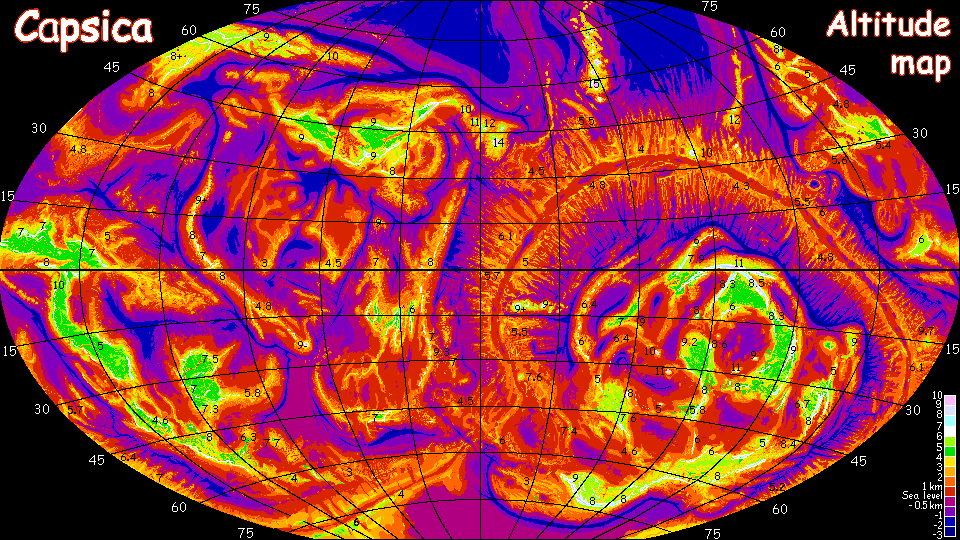
- Polar caps = none.
Polar conditions are Terran subtropical to temperate, rarely freezing at sea level (some winter nights do get frost). But Capsica's not quite ice-free: one Arctic and two Antarctic highlands get serious snow each winter, and have peaks high enough to sustain glaciers--exotic objects of much study. But extensive icefields never developed. In the Arctic, where orbital winter and local winter coincide, the snowline can drop to sea level, but there's little land to retain it--northern Nohaa and the Noktu Isles north of Bel are about it. Sea ice never builds up.
Since the poles don't ice up, shifts in the axial tilt aren't quite so vital as they are on cold worlds like Mars or Earth. There, big shifts can trigger polar meltdowns or freezes--and global droughts and floods as sealevels change. On Capsica, the cloudcover lessens the heat-gradient from tropics to poles; tilting and wobbling can force life to scramble as biozones shift, but tilting causes no worldwide climate catastrophes.
- Impact craters:
You won't spot many; only a couple are visible from orbit. The cratering rate is less than Earth's, and Capsica's manic geology erodes them faster. On the other hand, most meteors hit land or very shallow water, not deep sea, so more leave visible scars--initially. But they don't last long.
- Tectonic activity
= vigorous. Capsica's small, so internal heating from radioactives is modest, but tidal stresses more than compensate. The heat's dispersed both by volcanoes and many active rift zones. Hot-spot volcanic chains larger than Hawaii also rise from the basalt basins. Just as on Earth, crust spreads out from ridges, to eventually slip under highland plates, pushing up high coastal ranges with active volcanoes. The difference is that Capsica's rifts are mostly naked.
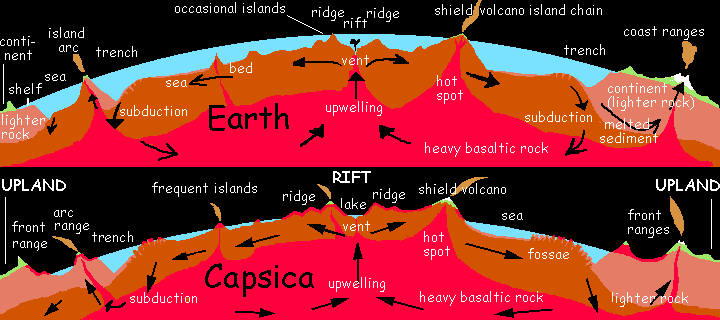
- Relief
= quite rugged! See altitude map above. Capsica's low gravity allows high peaks to build up, and the shallow seas expose them. Capsica's vigorous tectonics push up Himalayan-size ranges at plate boundaries, and huge near-Martian volcanoes rise over hot spots. The highest, Mt Heila on Nohaa, stands 15 km above sea level. (Mars's Olympus rises 26 above datum; Earth's Everest rises 13 km above the Indian abyssal plain). Capsica's deepest trench dips 7 km below sea level (our Mariana Trench is 11 km below the surface, 7 below the Pacific floor).
- Atmospheric chemistry
= nitrogen 75%, oxygen 21%, argon 4%, carbon dioxide 0.06%. Of course, it's no coincidence the air is fairly Earthlike on a living world. Life does that! I'm not pushing an extreme Gaia hypothesis, in which life deliberately generates an optimal envelope for itself (Earth's isn't optimal, after all--we have big dead zones.)
- Air pressure at sea level = 2.4 atmospheres.
Dense, but no Venus! Rather than greenhouse Capsica until it's uninhabitably hot (to the natives; yes, much of it is to you), this dense atmosphere actually makes life easier for the locals; with low gravity and dense air, nearly all large lifeforms fly. Low-tech societies have faster transport and communication than Earth's. And little social injustice: oppressed people here won't vote with their feet, but with wings. Hard to control populations that can just up and leave.
Note that the air isn't just denser at sea level; in Capsica's low gravity, the dropoff with altitude is slower. So at high elevations (and Capsica has great heights!) the air is thin but not stratospheric. Even atop Mt Heila (15 km up) the air's Tibetan but still breathable--much like 5 km up on Earth (16,500').
-
CO2 = 600 parts per million.
Heavy tidal stress keeps Capsica's volcanoes more active than Earth's, and Capsica's small seas can't always absorb it all. 600 ppm greenhouses Capsica more than that amount would (will?) on Earth; Capsican air's so dense this is more like a Terran level of 1500 ppm. Even this doesn't fully explain Capsica's heat; Earth's CO2 has been even higher without causing sauna-heat. Why is Capsica's greenhouse so strong, then? It's triple-glazed: high CO2, dense air, and the heat evaporates a lot of water--a second greenhouse gas.
This high level is fairly stable. The feedback loop: when CO2 rises, the climate heats, hurricanes become year-round and planet-wide. Rain increases, forests spread. Global jungle! Also, the rain weathers and exposes mountain rocks; both stone and wood lock up CO2 again. Low CO2 scales back the hurricanes to something more Terran, shrinking the forests. With less living vegetation or rain-weathering of rock to absorb CO2, levels rise again.
(Earth's less stable. During ice ages, forests die and deserts increase, but dust and glacial silt fertilizes seas that are nutrient-starved in warmer eras. Land plants die back, releasing CO2, but the seas bloom, sucking up CO2. Life's net effect is less, so on Earth inanimate factors like shifting currents, precession, volcanoes, drilling, mining, combustion (artificial or not) and the rise of new mountain ranges can all shift the CO2 level. But on Capsica, cooling causes big changes in forests, releasing CO2--and the long hot summer returns.)
-
Temperature.
Worldwide averages 323°K (50°C, 122°F). The lowlands are even hotter--mean temperature 333°K (60°C, 140°F)! All-time high: 95°C or 203°F. That's far below boiling point, by the way; in Capsica's dense air, water won't boil below 124°C/254°F. Sun-heated desert rock faces may hit boiling point, but air temperatures never do; certainly not ponds or creeks. Capsica is in no danger of boiling off like Venus. (And in no danger of becoming a global snowball, like poor Earth did once. Capsica's juuuuust right!)
The uplands and poles average only 313° K (40° C, 104° F)--even less (quite Terran) in the winter, though most summers climb back up into the roasting range. Near the poles on long winter nights it freezes, though sea ice never forms. And polar mountains can drop well below freezing--many have winter snow and a few have glaciers. Yep, Capsica has ice. Why not? So does Mercury--in a few choice spots. Location, location, location...
In ancient times, the sun (like most) was dimmer, but Capsica was already hotter than Terra during the Mesozoic (no Snowball Capsica--not with that dense atmosphere!) Warm-blooded life naturally settled on a core temperature above the environmental average (65-70°C, 150-159° F) and has stuck with it ever since. The real question is whether such life can settle the uplands easily--if maintaining core heat requires massive insulation or huge caloric intake, the uplands may be a biological backwater.
- Sky color: variable.
Dust levels vary greatly. The dense air can whip up stuff, but the humidity makes dust particles clump and drop. Blue to a smoggy green in the highlands, rose to lavender over deserts, salmon to gold over savannas, jade-green paling to white over most forests, and pale blue to white over the larger seas. Sunsets tend to be bloody, due to the dense and in places dusty air. Night skies: with a moon up, dark blue, not black. Even when all the moons are down, stars are fewer than Earth; dense humid air again.
- Cloud cover = dense
on average. High evaporation from bath-hot seas! The orbital photos don't show this; they're selectively cloudless, to show the land beneath.
- Albedo (reflectivity)
= high. The clouds reflect more light, and the seas (darker than land, on average) are smaller. However, most of the light that is absorbed gets converted into infrared...
- Climate zones
= Like Earth, Capsica has three great convection cells
- a tropical zone with damp rising air, fading to a drier monsoon zone away from the equator
- temperate zones, dry around thirty north & south, but rainy at higher latitudes up to sixty degrees
- dry, "cold" polar zones past sixty north
- Air loss over time = significant,
and that's good; most stars slowly brighten with age. That bleeding probably saved little Capsica from Venus's slow boil-off.
- Age = 6 billion Earth years. Not a problem; the sun will still outlive Sol by 2.5 billion years.
Life probably began in the rift lakes, and spread to the ocean(s). There have been many extinction events, mainly from impacts and from runaway greenhousing after vulcanism released too much CO2--this leads to Cloudball Capsica (and eventual cooling after sunless decades). One catastrophe's absent: no ice ages, ever.
- Total biomass = 60% of Earth's
--but remember, Capsica is small. The average density is high, about 120%. In the uplands it's 80%; in the lowlands 125% (more rainforests); in the seas, 133% (more shallows and reefs).
- Habitat diversity = higher than Earth.
The seas range from brackish to way saltier than Earth's (and siltier). The lowland coasts are stormforest, rainforest and monsoon forest opening into savanna and desert inland. The uplands are like Earth in microcosm, though Capsican higher (animal) life is sparse there.
- Biodiversity = schizoid.
The lowlands are surprisingly uniform: given the dense air, most animals fly, so all lowlands and seas are easily accessible; even swimmers and walkers can circle the planet. No isolated continents as on Earth! The uplands, though smaller, are more diverse: each one evolves unique solutions to the low-temperature problem.
- Intelligent species = multiple and diverse.
The sea supports amphibious reef dwellers and winged, diving fishers; the lowland woods shelter fructivorous and omnivorous arboreals and fliers; grazers and predators roam the savannas and deserts; the uplands have sparser animal life, but are full of oddball species. See Peoples of Capsica... once I've written it.
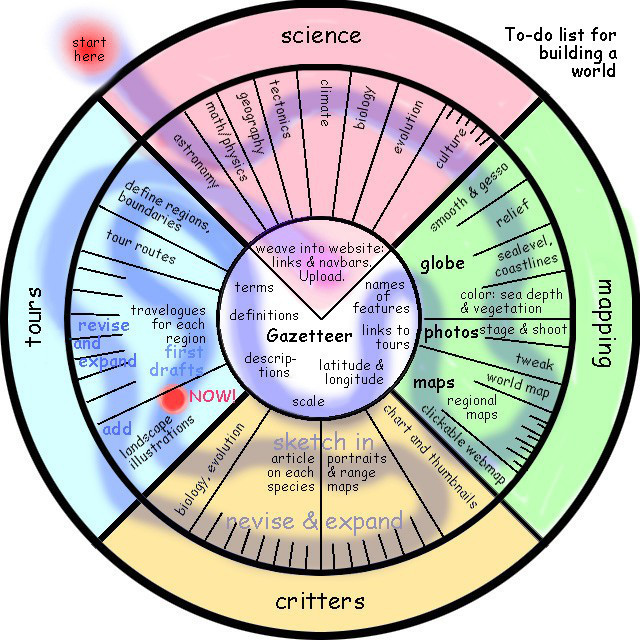
- Nomenclature=
Most seas, continents and major lobes echo terms for hot stuff (foods, weather, tools, actions, emotions) in various Earth languages, rendered phonetically: Hala Penyo, Welda, Chao. In uplands and near poles, colder names appear--Kyukamba, Aiskrim, Tshil. The gazetteer indexes all placenames, with their origins.
- State of the Project:
Done: the ecology and detailed world map plus regional maps, a gazetteer and basic tours for 100% of the surface now. I've sketched the first few landscapes and species, but flora, fauna, people and culture remain hazy. Radial chart at right shows which steps are completed and what's still to come. Just follow the worm!
- A Personal Note:
Some longtime fans have asked why I'm making you tour this scorching world unprotected. Must ALL of Planetocopia be so low-tech? Some airconditioned lodges and floatplanes to link them, and Terrans could tour more easily. Easier on me the writer too! Now the heat shapes the path, pace, and season of every tour--makes much of the planet off limits. So... why?
- Intellectually, I wanted to rub it in that Earth is cold--just 14° above freezing! What if we're cryophilic organisms without even knowing it, wildly biased in our hunt for biospheres? Capsica's not hot, it's mild: midway between ice & steam, as far from both as a world can get! "The fault, dear Brutus, is not in the stars, but in ourselves..." All that exuberant Capsican life you can't touch, the lowlands you can't even visit, are meant to make you feel like a biological freak--because you are. Maybe.
- Esthetically, travel by muscle power makes you feel just how big a planet is. Truth is, I cheat a bit to ease your way--make winds favorable, transit times brisk, parasites incompatible, allergens and poisons rare and accidents nonexistent. In real life such journeys are slower, harder, sicker... more limited.
- Emotionally: now, twelve years into my slow building of survivable Capsican tours, I realize I've insisted on native-style travel because it's what I know. I rarely fly and never take package tours, because I can't. I (and my sisters; it's genetic) have strong environmental illness. It's safer for me to climb a mountain, explore a cave or hike a desert canyon alone than to enter a sealed new building, airliner or airconditioned bus. Whole cities are off limits for me--smog! My travel's been by foot, bike and old car (outgassed completely). So the travel-problems Capsica poses are, to me, normal. I've favored minimalist travel Capsican-style because it's me.
Being me is educational. Hiking, you detour freely, see more, learn to watch for water and shelter. Biking, you learn to take back streets, find passes through hills and navigate by landforms. Driving old cars without air conditioning, you learn to time trips so you cross deserts at dawn or evening and rest up in hills, in shade or by a swimming hole through the afternoon heat, and you don't climb high passes casually--will the engine make it? The plane, the airconditioned bus, the guide... all cushion you. And you stay... citified.
Looking back now, Planetocopia's always had this theme: Lyr, that huge sea-world, has long hazardous flights over water taking careful planning; Kakalea has thin air making mountains impassible to Terrans, and inland deserts restricting even native civilization to coastal strips; Tharn has vast dry plains tourable only by slow caravan, but deep subduction trenches too, where flight's practical and travel fast.
You learn the land by its power over you.
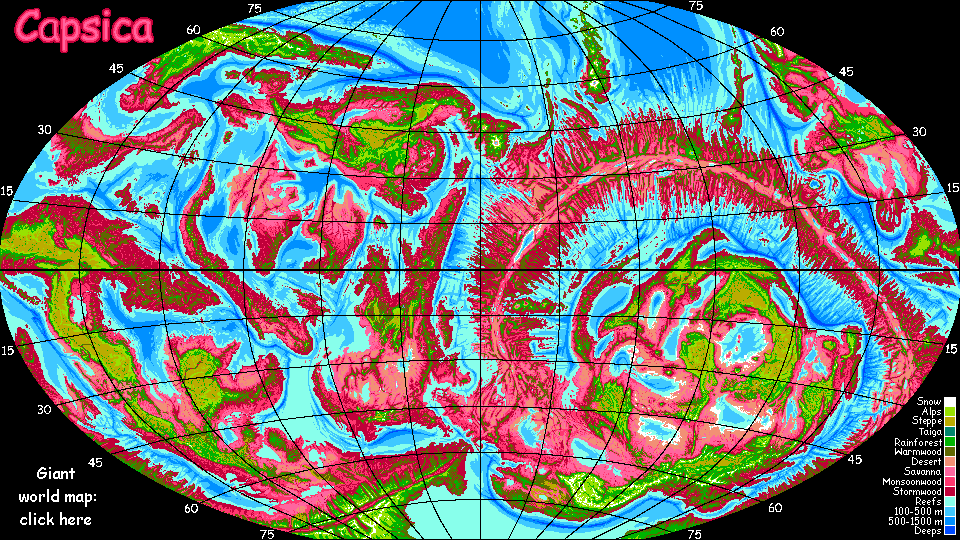
LISTS AND LINKS: more world-models:
Planetocopia - dreams of
other worlds -
ecology -
climate -
hot & cold-
evolution -
anarchy &
utopias -
sculptures & 3D art
World Dream Bank homepage- Art
gallery- New stuff- Introductory sampler, best
dreams, best art- On dreamwork- Books
Indexes: Subject- Author- Date- Names- Places- Art
media/styles
Titles: A- B- C- D- E- F- G- H- IJ- KL- M- NO- PQ- R- Sa-Sk- Sl-Sz- T- UV- WXYZ
Email: wdreamb@yahoo.com- Catalogof art, books, CDs - Behind the Curtain:FAQs, bio, site map - Kindred sites
Capsica
Capsica